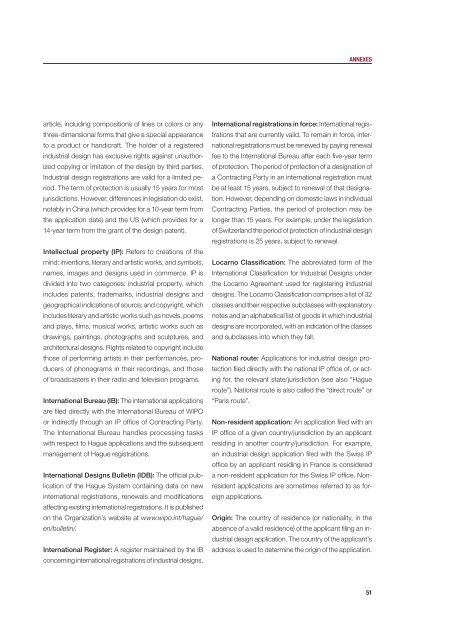wEyG1
wEyG1
wEyG1
You also want an ePaper? Increase the reach of your titles
YUMPU automatically turns print PDFs into web optimized ePapers that Google loves.
ANNEXES<br />
article, including compositions of lines or colors or any<br />
three-dimensional forms that give a special appearance<br />
to a product or handicraft. The holder of a registered<br />
industrial design has exclusive rights against unauthorized<br />
copying or imitation of the design by third parties.<br />
Industrial design registrations are valid for a limited period.<br />
The term of protection is usually 15 years for most<br />
jurisdictions. However, differences in legislation do exist,<br />
notably in China (which provides for a 10-year term from<br />
the application date) and the US (which provides for a<br />
14-year term from the grant of the design patent).<br />
Intellectual property (IP): Refers to creations of the<br />
mind: inventions, literary and artistic works, and symbols,<br />
names, images and designs used in commerce. IP is<br />
divided into two categories: industrial property, which<br />
includes patents, trademarks, industrial designs and<br />
geographical indications of source; and copyright, which<br />
includes literary and artistic works such as novels, poems<br />
and plays, films, musical works, artistic works such as<br />
drawings, paintings, photographs and sculptures, and<br />
architectural designs. Rights related to copyright include<br />
those of performing artists in their performances, producers<br />
of phonograms in their recordings, and those<br />
of broadcasters in their radio and television programs.<br />
International Bureau (IB): The international applications<br />
are filed directly with the International Bureau of WIPO<br />
or indirectly through an IP office of Contracting Party.<br />
The International Bureau handles processing tasks<br />
with respect to Hague applications and the subsequent<br />
management of Hague registrations.<br />
International Designs Bulletin (IDB): The official publication<br />
of the Hague System containing data on new<br />
international registrations, renewals and modifications<br />
affecting existing international registrations. It is published<br />
on the Organization’s website at www.wipo.int/hague/<br />
en/bulletin/.<br />
International Register: A register maintained by the IB<br />
concerning international registrations of industrial designs.<br />
International registrations in force: International registrations<br />
that are currently valid. To remain in force, international<br />
registrations must be renewed by paying renewal<br />
fee to the International Bureau after each five-year term<br />
of protection. The period of protection of a designation of<br />
a Contracting Party in an international registration must<br />
be at least 15 years, subject to renewal of that designation.<br />
However, depending on domestic laws in individual<br />
Contracting Parties, the period of protection may be<br />
longer than 15 years. For example, under the legislation<br />
of Switzerland the period of protection of industrial design<br />
registrations is 25 years, subject to renewal.<br />
Locarno Classification: The abbreviated form of the<br />
International Classification for Industrial Designs under<br />
the Locarno Agreement used for registering industrial<br />
designs. The Locarno Classification comprises a list of 32<br />
classes and their respective subclasses with explanatory<br />
notes and an alphabetical list of goods in which industrial<br />
designs are incorporated, with an indication of the classes<br />
and subclasses into which they fall.<br />
National route: Applications for industrial design protection<br />
filed directly with the national IP office of, or acting<br />
for, the relevant state/jurisdiction (see also “Hague<br />
route”). National route is also called the “direct route” or<br />
“Paris route”.<br />
Non-resident application: An application filed with an<br />
IP office of a given country/jurisdiction by an applicant<br />
residing in another country/jurisdiction. For example,<br />
an industrial design application filed with the Swiss IP<br />
office by an applicant residing in France is considered<br />
a non-resident application for the Swiss IP office. Nonresident<br />
applications are sometimes referred to as foreign<br />
applications.<br />
Origin: The country of residence (or nationality, in the<br />
absence of a valid residence) of the applicant filing an industrial<br />
design application. The country of the applicant’s<br />
address is used to determine the origin of the application.<br />
51


